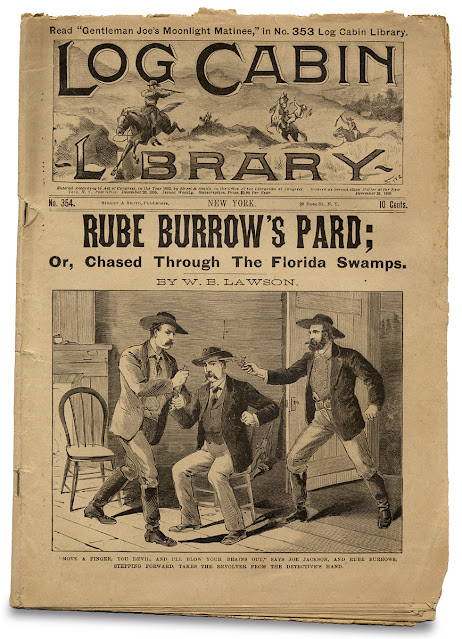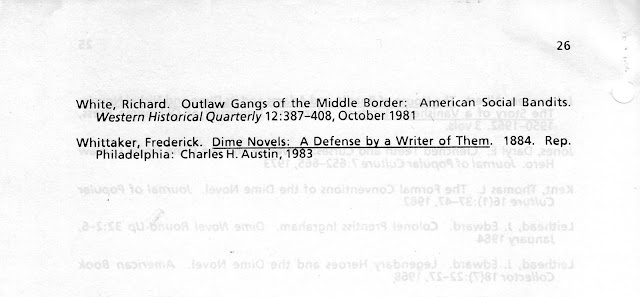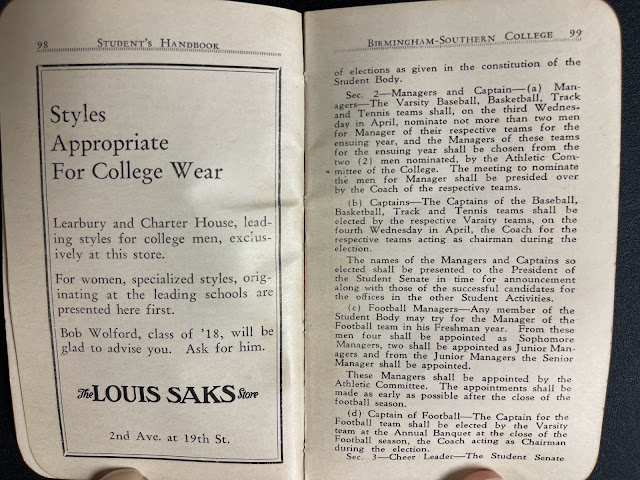The financial woes of Birmingham-Southern College have been in the news a lot lately. As I continue to downsize my book collection, I recently came across this BSC student handbook for the 1927-1928 school year. Funny how things work out sometimes....
Roots of the school date back to 1856. In its current form BSC has existed since 1918, when the Methodist Church merged two of its schools at the present location. So this handbook gives us a snapshot of the institution and its students a decade later.
This small handbook is 5" x 3" in size and has 112 pages, so it's meant to fit easily into a coat or shirt pocket or purse. My copy is in fairly good condition, but shows some use as well. Unfortunately its owner did not fill in the "This handbook is the property of" form on page 2. There are no markings in the entire book, actually.
I have some comments below many of the photos.
A history of BSC's first century is Birmingham-Southern College, 1856-1956 by Joseph H. Parks and Oliver C. Weaver, Jr. [Parthenon Press, 1957].
If this 1927-28 handbook is volume six, then the first one was issued in the 1922-23 school year.
Some of the neat things about this little publication are the vintage advertisements such as this one for Loveman, Joseph & Loeb. The Birmingham department store eventually became Loveman's, which had several stores around the state and operated from 1887 until 1980.
Comments from editor Clay Bailey in his "Foreword" welcome students and tell them what they can expect--"multiplied privileges of residence and study" which he lists, as well as "the companionship of scholars and gentlemen" who will introduce students to the "treasures of art, literature, religion and science."
Whiting's photo is the only one of an individual in the text of the book that's not an advertisement.
On the next page is an admonition to freshman to familiarize themselves with BSC's traditions and ideals so they can have the privilege of contributing to them.
I guess the "Football Song" has been replaced by the "Fight Song".
Apparently a number of fraternities were active at BSC in 1927.
Football was an important activity at BSC during the 1920s. The two schools that Methodists consolidated in 1918, Southern University and Birmingham College, both fielded football teams beginning in 1904 and 1909 respectively. After the merger, BSC compiled an 87-80-16 record between 1918 and 1939, when the school dropped football until bringing it back in 2007. The school won Dixie Conference championships in 1932, 1934 and 1937.
The handbook describes the prospect of a good season, touting two particular players and the number returning from the 1926 team, However, in the fall of 1927 BSC had a 3-6 record under coach Harold Drew; that was his final of four years. As you can see from the schedule in the photos above and below, BSC only played two games at the Munger Bowl, their home field. Two games were played at Rickwood Field, including the final one against arch rival Howard College, now Samford University.
The Alabama Theatre opened in December 1927 and became the premier venue in the city for Paramount Studios' theater division. The Strand had held that place until then. The Strand closed in 1962 and was demolished the next year; the Alabama thrives today.
Louis Saks' store operated in downtown Birmingham from the 1880's until the 1920's.
Protective was founded in Birmingham in 1907 by a former governor, William Jelks. In 2014 the company was sold to a Japanese firm, but continues to operate from Alabama.
Frank Lollar opened his first camera shop in Birmingham in 1910; by 1965 a sixth store opened in Eastwood Mall.
The Florsheim Shoes company was founded in Chicago in 1892 and continues to operate today.
I've yet to discover the relationship between Louis and Herman Saks in Birmingham or any possible relationship to the chain founded by Andrew Saks.






















































